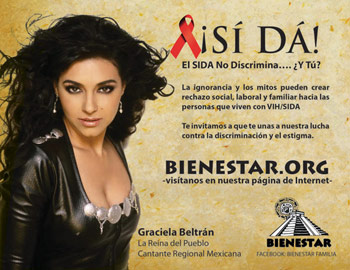Primera Parte – Estamos muy cerca de cumplir 30 años de lo que ahora conocemos como el VIH/SIDA. Fue el 5 de junio de 1981 cuando una publicación de los Centros de Control de Enfermedades y Prevención de Los Estados Unidos (CDC por sus siglas en inglés) informaron de 5 casos de hasta entonces un raro caso de neumonía en Los Angeles. Lo único en común en estos pacientes era que todos eran hombres gays. A partir de entonces hemos sido testigos del cambio de color de la epidemia, gradualmente se convirtió de una infección que afectaba principalmente a la comunidad blanca a impactar desproporcionadamente a la comunidad latina y afro-americana.
¿Qué hemos aprendido en esta cruzada? ¿Por qué la comunidad gay y transgénero continúan en mayor riesgo de esta pandemia? ¿Por qué el exámen del VIH sigue siendo de importancia fundamental en la prevención del VIH?
En estos 30 años, hemos aprendido en detalle las formas en que se transmite el virus y las formas de evitar el contacto, hemos desarrollado programas de prevención tanto a nivel local como intervenciones recomendadas por los CDC que han demostrado ser eficaces en reducir los riesgos de infección o transmisión del VIH. El exámen se volvió más sencillo y los resultados se entregan en 25 minutos e incluso en algunos países se entregan resultados en un minuto, pero todo esto no ha sido suficiente.
 El estigma asociado al VIH continúa impactando los esfuerzos de prevención y de normalizar el exámen del VIH e investigaciones del CDC resaltan cifras alarmantemente altas del VIH/SIDA en la comunidad gay. En una muestra de hombres gays en cinco ciudades de Estados Unidos, hasta el 25% vivían con VIH y el 48% desconocía su infección. Las pruebas tardías fueron comunes y el 45% de los diagnósticos de SIDA se dieron entre hombres que habían sido diagnosticados menos de doce meses antes. Desafortunadamente no hay información específica a nivel nacional en relación a la prevalencia del VIH en la comunidad transgénero. BIENESTAR en un esfuerzo para reducir el estigma asociado al VIH/SIDA ha desarrollado una campaña de concientización con la famosa cantante regional mexicana Graciela Beltrán.
El estigma asociado al VIH continúa impactando los esfuerzos de prevención y de normalizar el exámen del VIH e investigaciones del CDC resaltan cifras alarmantemente altas del VIH/SIDA en la comunidad gay. En una muestra de hombres gays en cinco ciudades de Estados Unidos, hasta el 25% vivían con VIH y el 48% desconocía su infección. Las pruebas tardías fueron comunes y el 45% de los diagnósticos de SIDA se dieron entre hombres que habían sido diagnosticados menos de doce meses antes. Desafortunadamente no hay información específica a nivel nacional en relación a la prevalencia del VIH en la comunidad transgénero. BIENESTAR en un esfuerzo para reducir el estigma asociado al VIH/SIDA ha desarrollado una campaña de concientización con la famosa cantante regional mexicana Graciela Beltrán.
¿Por que ha pesar de todo el conocimiento nuestra comunidad gay y transgénero continúa poniéndose en riesgo? ¿Qué otras estrategias existen para reducir la taza de infección? En la próxima edición continuaremos con esta información.
BIENESTAR en sus 9 centros comunitarios en el sur de California te ofrece las herramientas para llevar una vida más saludable e incrementar tu red social, para más información de los programas y servicios visita la página electrónica www.bienestar.org y únete a nosotros en Facebook: Bienestar Familia.
30 Years of Struggle and Survival
It was nearly 30 years ago that we were first introduced to what we would now know as HIV/AIDS. On June 5, 1981 a publication from the Centers for Disease Control and Prevention (CDC) reported 5 cases of a rare case of pneumonia in Los Angeles. The only commonality amongst these patients was that they were all gay men. Since then we have witnessed a change in the communities impacted by the epidemic. Over the years we gradually witnessed a transition from an infection mainly affecting the white community to one that disproportionately impacts Latinos and African-Americans.
What have we learned in this crusade? Why are the gay and transgender communities still at greater risk of the pandemic? Why does HIV testing remain critical in preventing HIV?
Within the past 30 years we have learned many details regarding the ways in which the virus is transmitted and ways to avoid contact. We have developed local prevention programs and implemented interventions recommended by the CDC that have proven effective in reducing risk of HIV infection and/or transmission. The HIV test became easier and the results are delivered in 25 minutes and in some countries deliver results in a minute…. but this has not been enough.
The stigma associated with HIV continues to impact prevention efforts and the encouragement of HIV testing, CDC investigations highlight alarmingly high numbers of HIV / AIDS in the gay community. In a sample of gay men in five U.S. cities, up to 25% were living with HIV and 48% were unaware of their infection. It was common for men to test later in life and 45% of AIDS diagnoses were among men who had been diagnosed less than twelve months earlier. Unfortunately there is no specific information at the national level in relation to the prevalence of HIV in the transgender community. BIENESTAR continues our effort to reduce the stigma associated with HIV / AIDS and developed an awareness campaign with the famous Mexican singer Graciela Beltran.
Despite all the knowledge, why do our gay and transgender communities continue to put themselves at risk for infection? What other strategies exist to reduce the infection rate? In the next issue will continue with the exploration of this topic.
Through our 9 community centers located throughout Southern California BIENESTAR gives you the tools to increase your social network and lead a healthier life. For more information about programs and services visit our website at www.bienestar.org, contact one of our community centers, or join us on Facebook: Bienestar Familia
Por Victor Martínez – BIENESTAR

